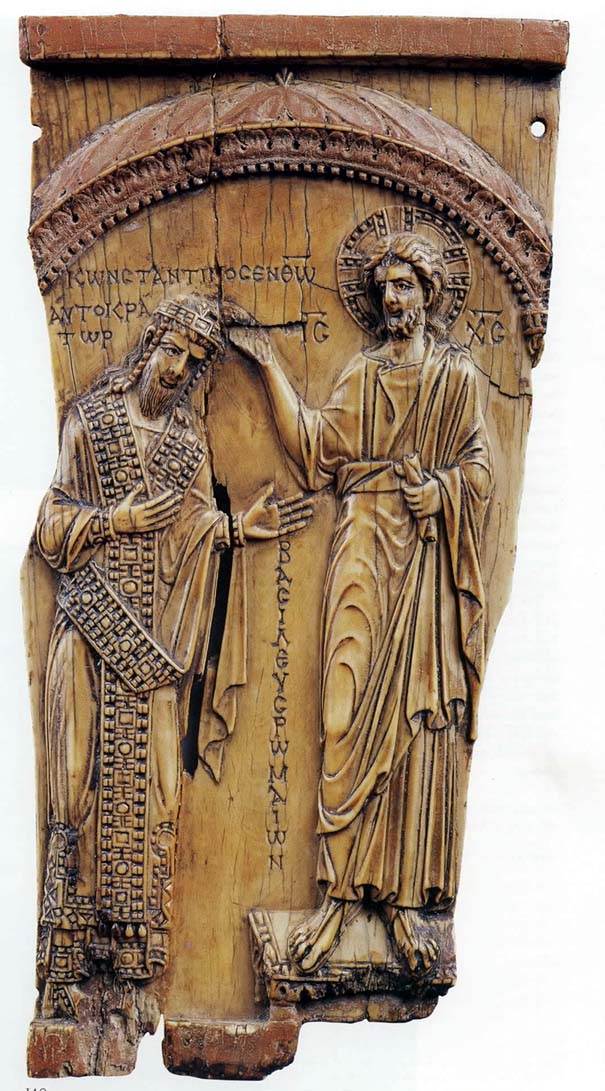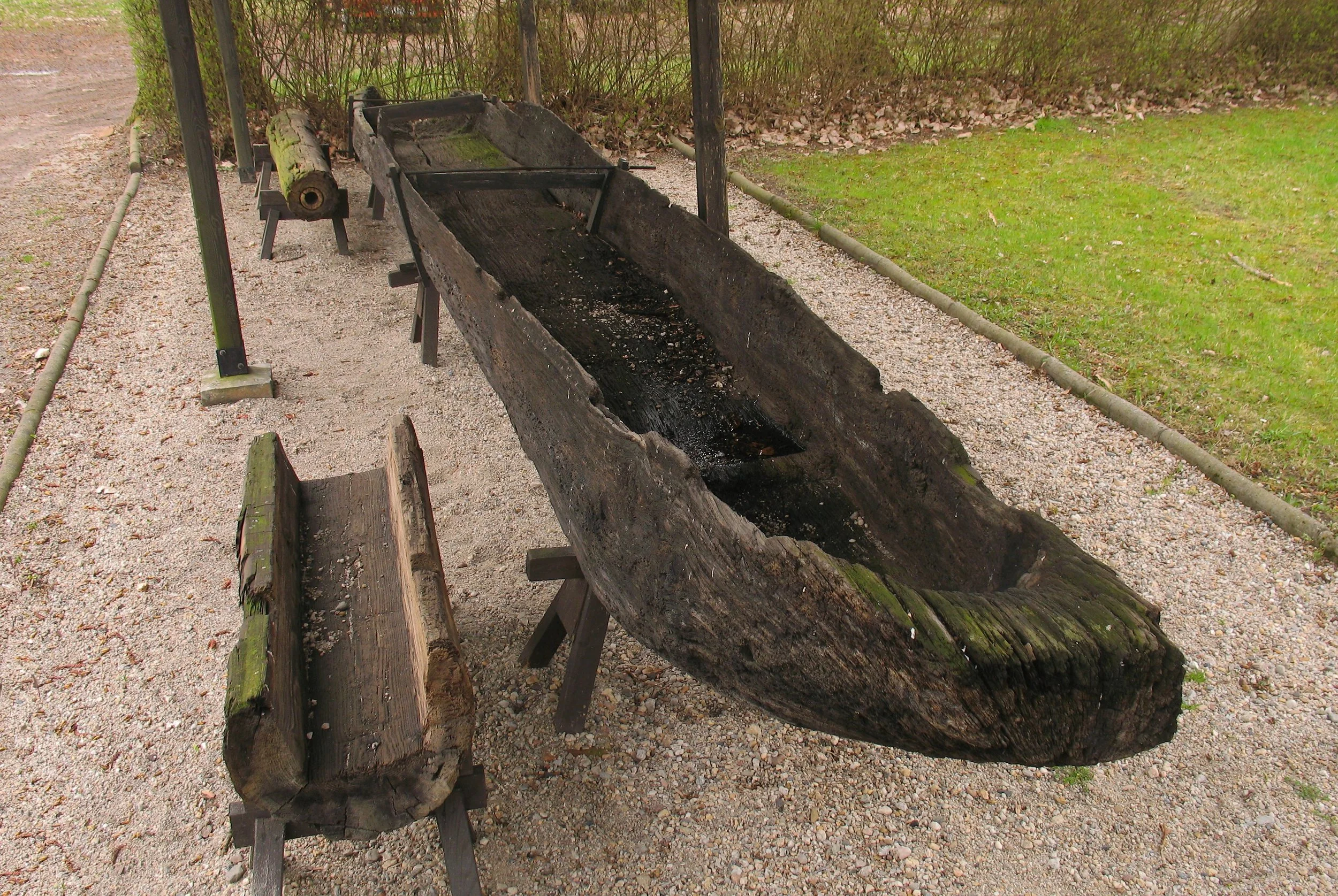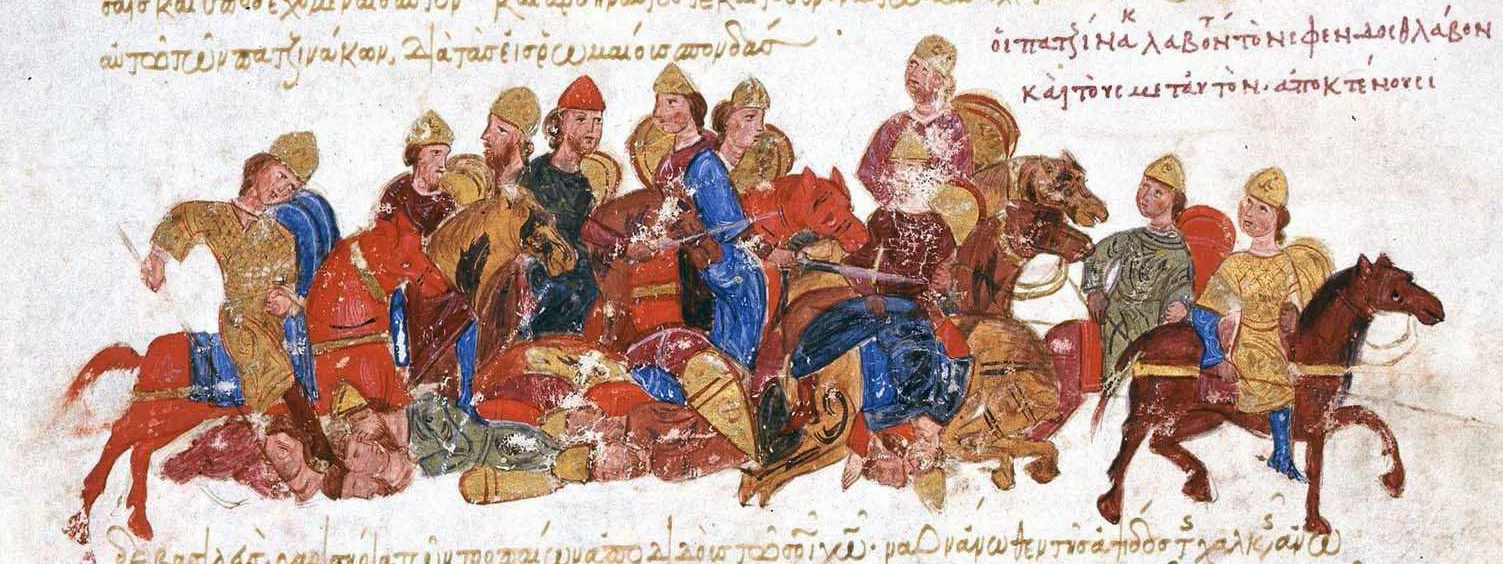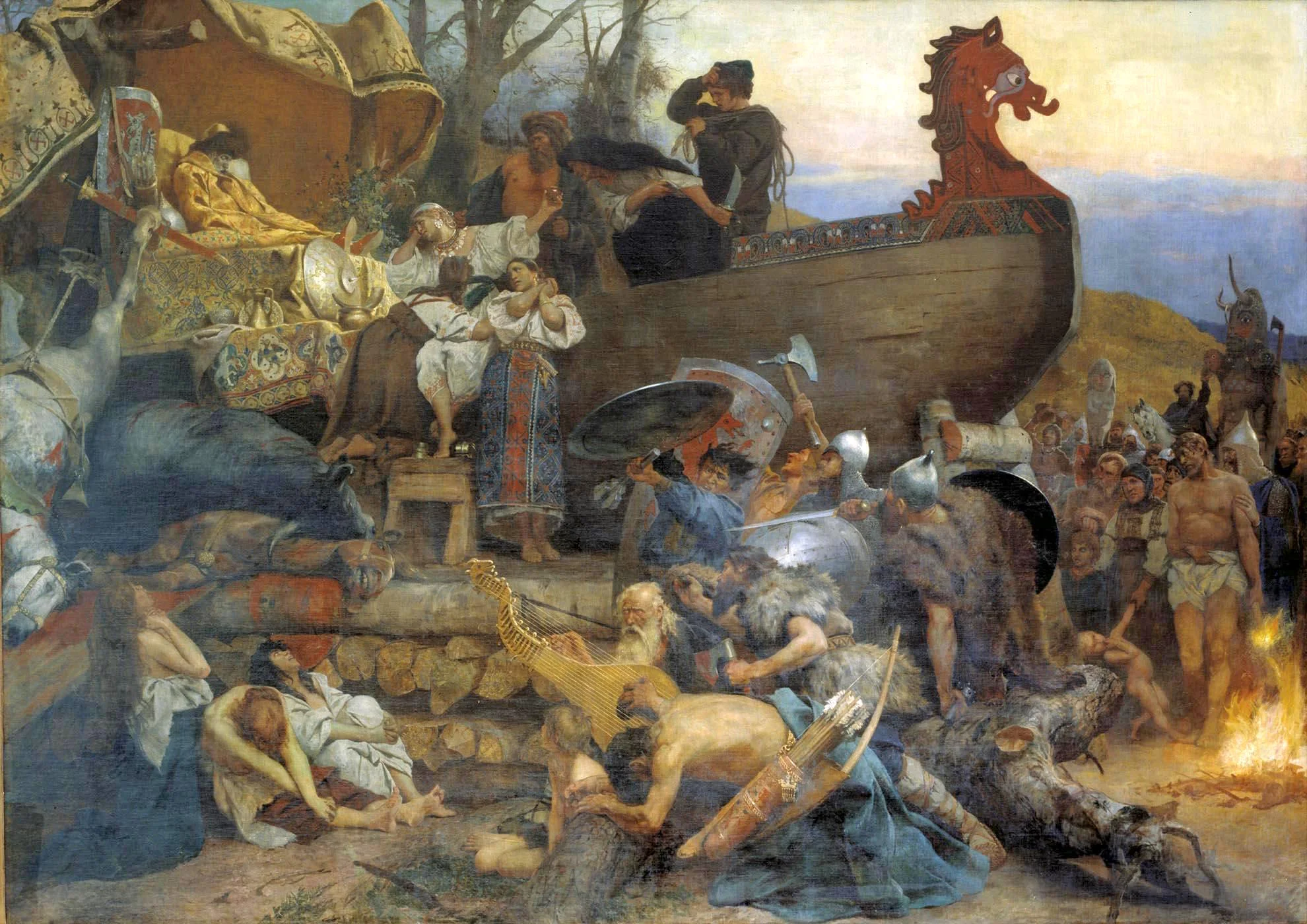The Account of Viking Traders and Travelers in De Administrando Imperio By Bethany Rogers
Constantine VII. : This piece of carved ivory from the Pushkin Museum shows Christ blessing Emperor Constantine VII, c. AD 945. The piece passed from the treasury at Etchmiadzin to the collection of Count Sergey Uvarov in the mid-19th century. ©Ghirlandajo, via Wikipedia.
De Administrando Imperio is a handbook written in Greek by the Eastern Roman Emperor Constantine VII in the 10th century. It is one of the first Byzantine accounts of contact between their empire and the Scandinavian people.
This work was created to aid Constantine’s son and heir in foreign diplomacy and domestic policy. Chapter 9 discusses Russian (Rus’) traders who arrive by river each year to sell their boats. Constantine VII was responsible for many written works during his lifetime; Warren Treadgold notes that
[he] was mainly interested in compiling reference works. He was far more a patron of writing than a writer, because most of the works attributed to him are virtually copied from earlier sources ... His On Administering the Empire is a jumble of disjointed facts.
Other sources from which De Administrando Imperio is copied include Theophanes Continuatus, and the Life of Basil, both either written or commissioned by Constantine. The author’s position as a king, writing about his empire and the surrounding cultures, seems to have imbued the narrative with a more factual overall view than some narratives by written by travelers to what they considered strange and unusual places. Or, as Treadgold points out, perhaps he was more concerned with preserving a jumble of what he hoped would be useful facts and was less concerned with comparing cultural merits. As a manual designed to help the ruler of the empire, the tone of the writing is straightforward.
It contains little judgement of the outside cultures, seen in other accounts such as when Ibn Fadlan called the Rus’ “the filthiest of all Allah’s creatures” and noted their disgusting habits of washing their faces in dirty water, or having sex with their slave girls in public. The author focuses on naming and describing various peoples and landmarks with which his son would presumably need to be familiar.
Elizabeth Jeffreys et al. note that Constantine VII made clear through his style of writing that, “the image of the barbarian faded away to reveal a multitude of individual peoples, with defined territories and constitutions, with distinctive histories and cultures. Not once is the word barbaroi used of any of the many neighboring peoples.” However, as a king writing to a future ruler Constantine believed his empire to be superior. Jeffreys et al. also note, “No overt claims are made to universal rule. The rights and independence of other states are recognized. … But Byzantium is presented as the central place, a superordinate power, around which others revolve, and to which many of them defer.” This bias does not seem to affect the account of the Russian traders, being a straightforward account of trade and the route the traders take across the Dnieper River. Perhaps it is due to the fact that the Rus’ are arriving to trade with their people, with the implication that they are the subordinates hoping to gain money and goods from these pursuits, that the superiority of Byzantium is understood and need not be spelled out.
Chapter 9 of this source contains an account of Russians traveling in monoxyla, simple boats made from hollowed out trees or carved from flat-bottomed pieces of wood, from Russia to Constantinople.
Monoxyla. A 10th century monoxyla boat found in the Oder river in Poland. It is currently in the Świdnica museum near Zielona Góra, Poland. ©Mohylek, via Wikimedia Commons
They arrive, the text tells us, when spring comes and the ice melts, in their boats down the Dnieper River, a great river which begins in Russia and flows through modern-day Belarus and Ukraine before emptying into the Black Sea. These foreigners entered Constantine’s territory regularly to trade, increasing the likelihood of an accurate account: frequent contact allows for more chances to observe practices and customs. The chapter describes the geography around the Dnieper River, and trading of monoxyla where the Rus’ cut and carve the wood for the simple ship, and then sail it downriver where those who wish to buy a new ship will take salvageable materials from their old one and fit out the new vessel.
The Rus’ men then travel over a series of rapids, picking up the ship with their hands and carrying it over the worst of the terrain with their other trade goods inside (unfortunately, the account doesn’t tell us what they may have traded other than slaves, focusing on the ordeal of the boats themselves). The men divide, with some disembarking to the banks of the river to lighten the load, some who strip off their clothes and get into the water to feel for rocks, and guide the remaining men in the stern of the vessel, who use long poles to navigate across the rocks.
The Pechenegs. This image from the chronicle of the 11th c. Greek historian, John Skylitze depicts the Pecheneg’s slaughter the “skyths” of Sviatoslav I of Kiev. From the Skyllitzes Matritensis, fol. 173r. ©MadridSkylitzes, via Wikimedia Commons.
Through three barrages, they repeat this process, and then transport their ship overland by either dragging it, or carrying it on their shoulders for some six miles, watching out for their mortal enemies, the Pechenegs, all the while. The text tells us they frequently engage in skirmishes with the Pechenegs going to and from their trading destination, and must always be vigilant. Eventually, the Rus’ stop at an island, St. Gregory, where they cast lots and make offerings of whatever they have, including sacrificing cocks. Sailing to another island called St. Aitherios, they rest for several days and re-equip their boats with tackle, sails, masts and rudders, and then continue home or on to other trading posts on the river.
The chapter is consistent with what is known historically about this period and corroborated by other sources. The names of the Dnieper rapids are given in Slavonic and Norse, supporting Ibn Fadlan’s account that these were a Scandinavian people. P.H. Sawyer notes, “[The names are] in the languages of both the Slavs and the Rus’, and several of the latter forms are certainly Scandinavian.”
The presence of Varangian traders on the island described in the chapter was further verified following the discovery of the Berezan’ Runestone in 1905, inscribed with runes saying, “[Gráni] made this sarcophagus for Karl, his partner.” The word “partner” in the inscription, félagi, is often used for business partners or comrades-in-arms, so it would fit that these men were traders or ship owners together, and one lost his life along the route.
The Arabic source Murij adh-dhahah by Al-mas’udi, written ca. AD 950, also confirms Russians in this area, calling them “masters of the Black Sea,” and noting that when they trade, “the Russians brought their vessels into this (the Caspian) sea, (from the Black Sea).” Now, we know that the area of the Dnieper River was traversable, and other accounts confirm the presence of Varangian or culturally Norse traders upon it.
Ship burial of a Rus chieftain. This serene was described by the Arab traveler Ahmad ibn Fadlan who visited Kievan Rus in the 10th century, painted by Henryk Siemiradzki (1883). WikimediaCommons
The account of De Administrando Imperio shows that the Vikings sailed all the way to Byzantium by including the names of various waterways and lakes along the way. The first step to proving that contact between two remote areas took place is proving that it is possible to travel between them.
After establishing that such travel was possible, and by which routes, scholars turned their attention to why the journey was undertaken: trade. Angus Somerville and R. Andrew McDonald’s book, The Vikings and their Age, explains accounts of trade between Byzantium and the Rus’ preserved in several later medieval chronicles, noting that typical trade goods included furs, honey, wax, walrus ivory, high-grade weapons and the slaves which De Administrando Imperio mentions.
Overall, this source is a useful and relatively unbiased account of the travel routes and customs of Rus’ traders on the Dnieper River in the tenth century which is particularly valuable in that it does not seem to judge the culture of the men it describes, instead painting a portrait of a lucrative yearly trading expedition for the author’s son, who would be the future king.
THIS ARTICLE WAS ORIGINALLY FEATURED IN ISSUE 115, MEDIEVAL TRAVEL.
IF YOU LIKE THIS AND WANT MORE, SUBSCRIBE BELOW!
About the Author
Beth has a BA in News-editorial journalism from the University of Illinois. In 2011, she received her Masters in Secondary Education with teaching certification in English Education. She holds a second MA in Medieval Icelandic Studies from the University of Iceland. She recently began a PhD at the University of Iceland exploring the cultural significance of dairy products in medieval Iceland.





